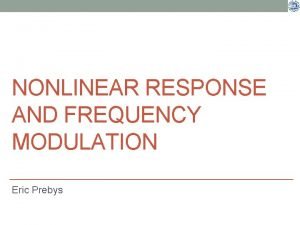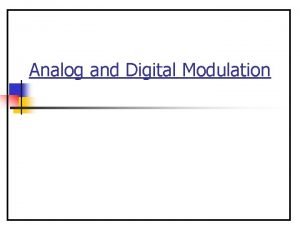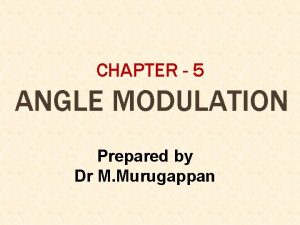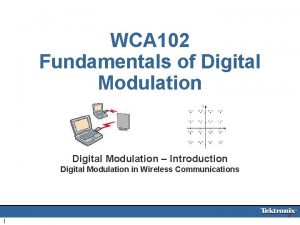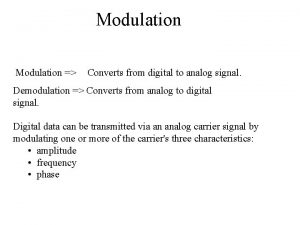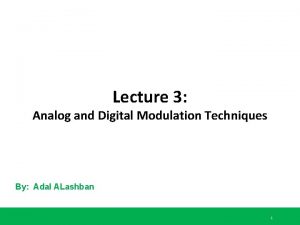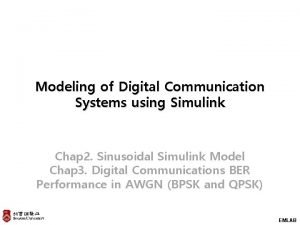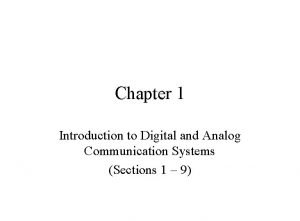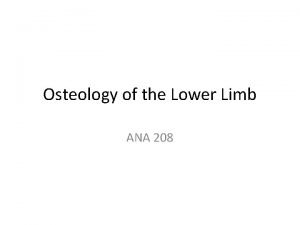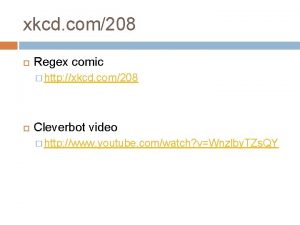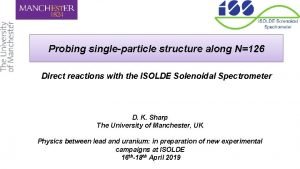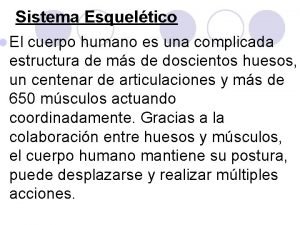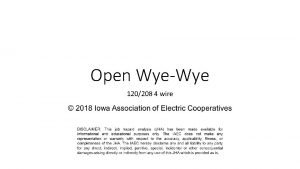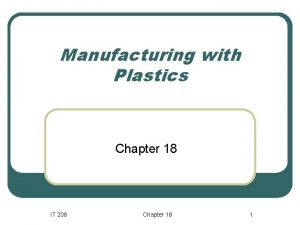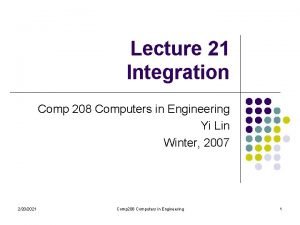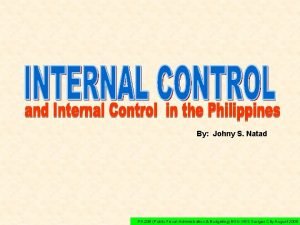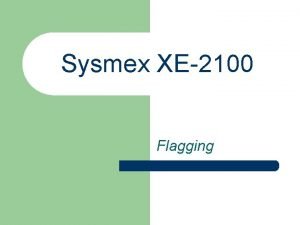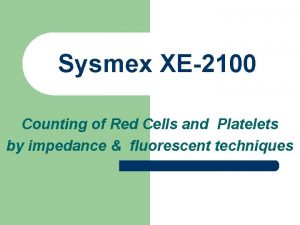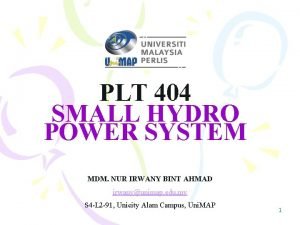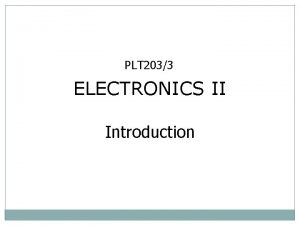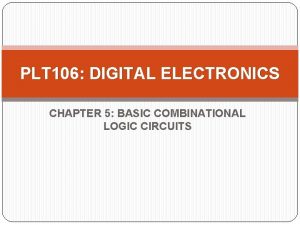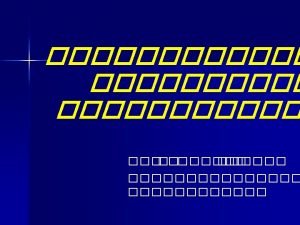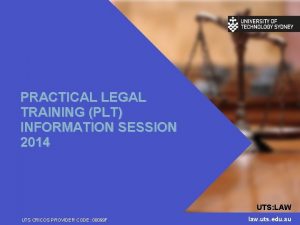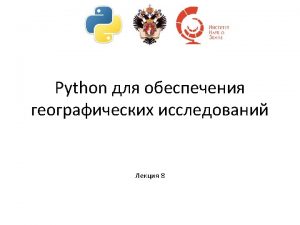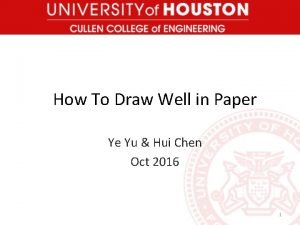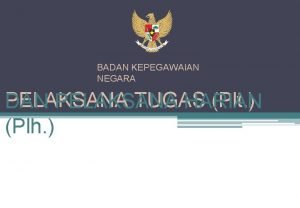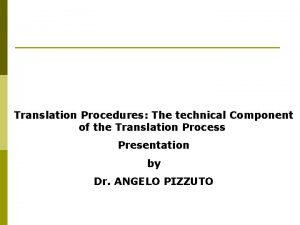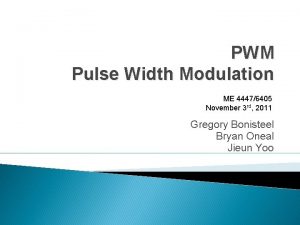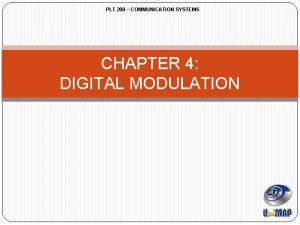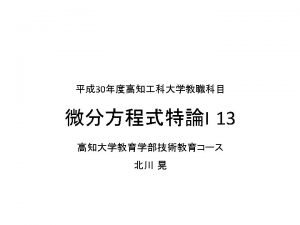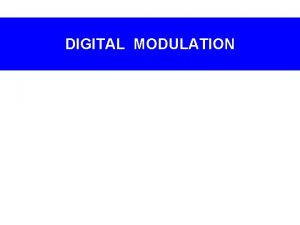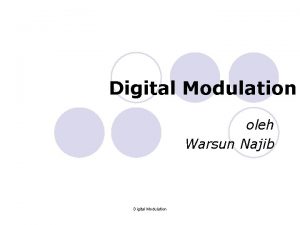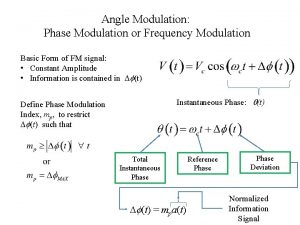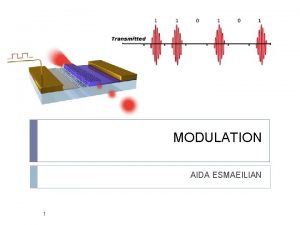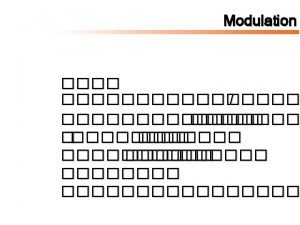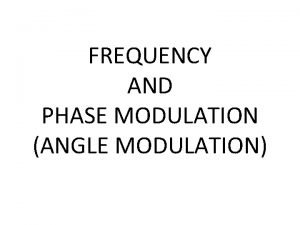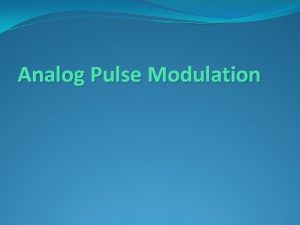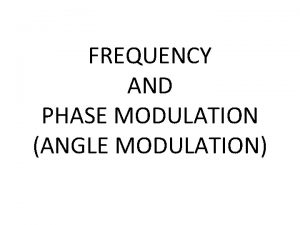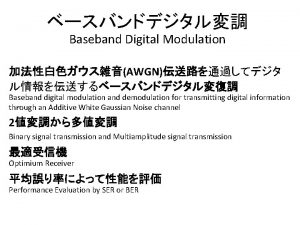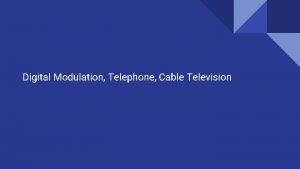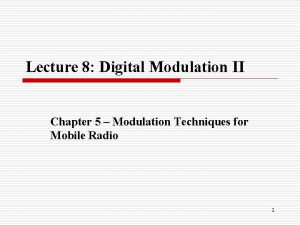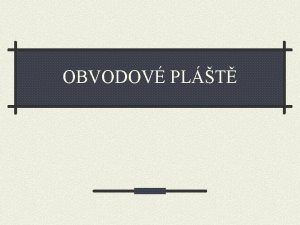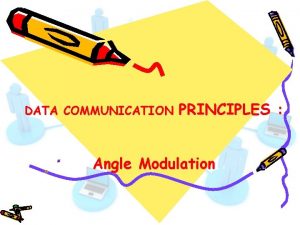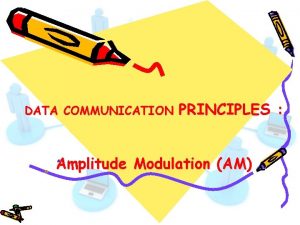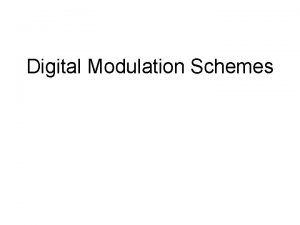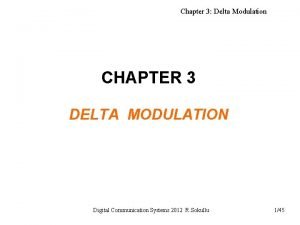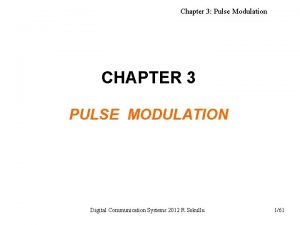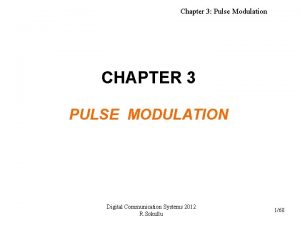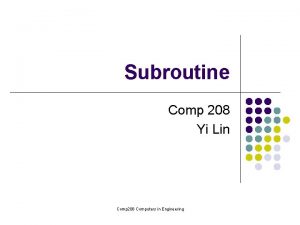PLT 208 COMMUNICATION SYSTEMS CHAPTER 4 DIGITAL MODULATION





















































- Slides: 53

PLT 208 – COMMUNICATION SYSTEMS CHAPTER 4: DIGITAL MODULATION

DIGITAL TRANSMISSION… a. b. c. d. Pulse Modulation Sampling Pulse Code Modulation Line Codes PLT 208 – COMMUNICATION SYSTEMS

DIGITAL TRANSMISSION… What is digital transmission? - the transmittal of digital signals between two or more points in a communications system. PLT 208 – COMMUNICATION SYSTEMS

Advantages & Drawbacks of Digital Transmission � Noise immunity. � Relatively low cost digital circuitry. � Able to be time division multiplexed with other pulse modulated signal. � Storage of digital streams. � Error detection & correction PLT 208 – COMMUNICATION SYSTEMS � Requires greater BW to transmit & receive as compared to its analog counterpart. � Special encoding & decoding methods must be used to increased transmission rates & more difficult to be recovered. � Requires precise synchronization of clocks between Tx & Rx.

PULSE MODULATION (PM)… �Sampling analog information signal. �Converting samples into discrete pulses. �Transport the pulses from source to destination over physical transmission medium. PLT 208 – COMMUNICATION SYSTEMS

METHODS OF PM… 1. 2. 3. 4. PAM PWM PPM PCM PLT 208 – COMMUNICATION SYSTEMS Analog Pulse Modulation Digital Pulse Modulation

METHODS OF PM… � Analog Pulse Modulation � Carrier signal is pulse waveform and the modulated signal is where one of the carrier signal’s characteristic (either amplitude, width or position) is changed according to information signal. PLT 208 – COMMUNICATION SYSTEMS

Pulse Amplitude Modulation (PAM) • The amplitude of pulses is varied in accordance with the information signal. • Width & position constant. PLT 208 – COMMUNICATION SYSTEMS

Pulse Width Modulation (PWM) • Sometimes called Pulse Duration Modulation (PDM) or pulse length modulation (PLM). • The width of pulses is varied in accordance to information signal. • Amplitude & position constant. PLT 208 – COMMUNICATION SYSTEMS

Pulse Position Modulation (PPM) • Modulation in which the temporal positions of the pulses are varied in accordance with some characteristic of the information signal. • Amplitude & width constant. PLT 208 – COMMUNICATION SYSTEMS

Pulse Code Modulation (PCM) • Analog signal is sampled • Converted to a serial n-bit binary code for transmission • Each code has same number of bits and requires same length of time for transmission PLT 208 – COMMUNICATION SYSTEMS

PLT 208 – COMMUNICATION SYSTEMS

SAMPLING … � A process of taking samples of information signal at a rate of Nyquist’s sampling frequency. � Nyquist’s Sampling Theorem : The original information signal can be reconstructed at the receiver with minimal distortion if the sampling rate in the pulse modulation system equal to or greater than twice the maximum information signal frequency. fs >= 2 fm (max) PLT 208 – COMMUNICATION SYSTEMS

SAMPLING … �Two basic techniques used to perform the sampling function: �Natural sampling �Flat-top sampling PLT 208 – COMMUNICATION SYSTEMS

Natural Sampling… �Tops of the sample pulses retain their natural shape during the sample interval. �Frequency spectrum of the sampled output is different from an ideal sample. �Amplitude of frequency components produced from narrow, finite-width sample pulses decreases for the higher harmonics �Requiring the use of frequency equalizers PLT 208 – COMMUNICATION SYSTEMS

Natural Sampling… PLT 208 – COMMUNICATION SYSTEMS

Flat-top Sampling… �Common used in PCM systems. �Accomplish in a sample-and-hold circuit �To periodically sample the continually changing analog input voltage & convert to a series of constant-amplitude PAM voltage levels. �The input voltage is sampled with a narrow pulse and then held relatively constant until the next sample is taken. PLT 208 – COMMUNICATION SYSTEMS

Flat-top Sampling… �Sampling process alters the frequency spectrum & introduces aperture error. �The amplitude of the sampled signal changes during the sample pulse time. �Advantages: �Introduces less aperture distortion �Can operate with a slower ADC PLT 208 – COMMUNICATION SYSTEMS

Flat-top Sampling… PLT 208 – COMMUNICATION SYSTEMS

Pulse Code Modulation (PCM)… �Basic scheme of PCM system �Quantization Error �Companding �Block diagram & function of TDM-PCM communication system PLT 208 – COMMUNICATION SYSTEMS

Basic Scheme Of PCM System �The most common technique for using digital signals to encode analog data is PCM. �Example: To transfer analog voice signals off a local loop to digital end office within the phone system, one uses a codec. PLT 208 – COMMUNICATION SYSTEMS

Basic Scheme Of PCM System �Because voice data limited to frequencies below 4000 Hz, a codec makes 8000 samples/sec. (i. e. , 125 microsecond/sample). �If a signal is sampled at regular intervals at a rate higher than twice the highest signal frequency, the samples contain all the information of the original signal. PLT 208 – COMMUNICATION SYSTEMS

PCM Block Diagram • Most common form of analog to digital modulation • Four step process 1. Signal is sampled using PAM (Sample) 2. Integer values assigned to signal (PAM) 3. Values converted to binary (Quantized) 4. Signal is digitally encoded for transmission (Encoded) PLT 208 – COMMUNICATION SYSTEMS

4 Steps Process… PLT 208 – COMMUNICATION SYSTEMS

� Analog signal is sampled. � Converted to discrete-time continuous-amplitude signal (Pulse Amplitude Modulation) � Pulses are quantized and assigned a digital value. � A 7 -bit sample allows 128 quantizing levels. � PCM uses non-linear encoding, i. e. , amplitude spacing of levels is non-linear � There is a greater number of quantizing steps for low amplitude � This reduces overall signal distortion. � This introduces quantizing error (or noise). � PCM pulses are then encoded into a digital bit stream. � 8000 samples/sec x 7 bits/sample = 56 Kbps for a single voice channel. PLT 208 – COMMUNICATION SYSTEMS

PCM Example PLT 208 – COMMUNICATION SYSTEMS

Quantization � A process of converting an infinite number of possibilities to a finite number of conditions (rounding off the amplitudes of flat-top samples to a manageable number of levels). PLT 208 – COMMUNICATION SYSTEMS

Analog input signal Sample pulse PAM signal PCM code PLT 208 – COMMUNICATION SYSTEMS

q The quantization interval @ quantum = the magnitude difference between adjacent steps. q The resolution = the magnitude of a quantum = the voltage of the minimum step size. q The quantization error = the quantization noise = ½ quantum = (orig. sample voltage – quantize level) q PCM code = (sample voltage/resolution) PLT 208 – COMMUNICATION SYSTEMS

Quantization Error � A difference between the exact value of the analog signal & the nearest quantization level. PLT 208 – COMMUNICATION SYSTEMS

Types of Quantization Midtread PLT 208 – COMMUNICATION SYSTEMS Midrise

Types of Quantizer 1. Uniform type : The levels of the quantized amplitude are uniformly spaced. 2. Non-uniform type : The levels are not uniform. PLT 208 – COMMUNICATION SYSTEMS

Dynamic Range (DR) � Largest possible magnitude/smallest possible magnitude. � Where � DR = absolute value of dynamic range � Vmax = the maximum voltage magnitude � Vmin = the quantum value (resolution) � n = number of bits in the PCM code PLT 208 – COMMUNICATION SYSTEMS

Example 1 1. Calculate the dynamic range for a linear PCM system using 16 -bit quantizing. 2. Calculate the number of bits in PCM code if the DR = 192. 6 d. B PLT 208 – COMMUNICATION SYSTEMS

Coding Efficiency �A numerical indication of how efficiently a PCM code is utilized. �The ratio of the minimum number of bits required to achieve a certain dynamic range to the actual number of PCM bits used. Coding Efficiency = Minimum number of bits x 100 Actual number of bits PLT 208 – COMMUNICATION SYSTEMS

Signal to Quantization Noise Ratio (SQR) � The worst-case voltage SQR R =resistance (ohm) � SQR for a maximum input signal v = rms signal voltage q = quantization interval � The signal power-to-quantizing noise power ratio PLT 208 – COMMUNICATION SYSTEMS

Example 2 1. Calculate the SQR (d. B) if the input signal = 2 Vrms and the quantization noise magnitudes = 0. 02 V. 2. Determine the voltage of the input signals if the SQR = 36. 82 d. B and q =0. 2 V. PLT 208 – COMMUNICATION SYSTEMS

Effect of Non-Linear Coding PLT 208 – COMMUNICATION SYSTEMS

Nonlinear Encoding �Quantization levels not evenly spaced �Reduces overall signal distortion �Can also be done by companding PLT 208 – COMMUNICATION SYSTEMS

Companding • The process of compressing and then expanding. • The higher amplitude analog signals are compressed prior to transmission and then expanded in receiver. • Improving the DR of a communication system. PLT 208 – COMMUNICATION SYSTEMS

Companding Functions PLT 208 – COMMUNICATION SYSTEMS

PCM System with Analog Companding PLT 208 – COMMUNICATION SYSTEMS

Digitally Companded PCM System PLT 208 – COMMUNICATION SYSTEMS

Method of Companding For the compression, two laws are adopted: the -law in US and Japan and the A-law in Europe. -law A-law Vmax= Max uncompressed analog input voltage Vin= amplitude of the input signal at a particular of instant time Vout= compressed output amplitude A, = parameter define the amount of compression The typical values used in practice are: =255 and A=87. 6. After quantization the different quantized levels have to be represented in a form suitable for transmission. This is done via an encoding process. PLT 208 – COMMUNICATION SYSTEMS

μ-law PLT 208 – COMMUNICATION SYSTEMS A-law

PCM Line Speed � The data rate at which serial PCM bits are clocked out of the PCM encoder onto the transmission line. � Where �Line speed = the transmission rate in bits per second �Sample/second = sample rate, fs �Bits/sample = no of bits in the compressed PCM code PLT 208 – COMMUNICATION SYSTEMS

Example 3 1. For a single PCM system with a sample rate fs = 6000 samples per second a 7 bits compressed PCM code, calculate the line speed. PLT 208 – COMMUNICATION SYSTEMS

Virtues & Limitation of PCM The most important advantages of PCM are: �Robustness to channel noise and interference. �Efficient regeneration of the coded signal along the channel path. �Efficient exchange between BT and SNR. �Uniformat for different kind of base-band signals. �Flexible TDM. PLT 208 – COMMUNICATION SYSTEMS

Virtues & Limitation of PCM �Secure communication through the use of special modulation schemes of encryption. �These advantages are obtained at the cost of more complexity and increased BT. �With cost-effective implementations, the cost issue no longer a problem of concern. �With the availability of wide-band communication channels and the use of sophisticated data compression techniques, the large bandwidth is not a serious problem. PLT 208 – COMMUNICATION SYSTEMS

� Introduction �The normal line codes (bipolar binary code & unipolar binary code are not suitable for line transmission purposes. Both suffer from existence of strong frequency component at low frequencies and lack of signal transition when long strings of identical symbols are transmitted sequentially. �Thus, the line codes have been developed which have properties which make them particularly useful for line transmission. �By using various coding techniques, known as LINE CODES, it is often possible to match the spectrum of the transmitted signal to the available channel. PLT 208 – COMMUNICATION SYSTEMS

Line Coding - process of converting binary data (sequence of bits) to a digital signal. Data levels – number of values/levels used to represent data (typically 0 and 1) Signal levels – number of values/levels allowed in a particular signal. PLT 208 – COMMUNICATION SYSTEMS

Transparency – the code must not impose any restriction content to the transmitted message. Unique decodability – each output symbol must be clearly decoded to give the original sequence of input bits. Efficiency – each symbol of the code should contribute to the transmission of the incoming signal. Favorable energy spectrum – the presence of transformer and coupling capacitor requires line code to have a DC component averaging zero and very small low frequency components. PLT 208 – COMMUNICATION SYSTEMS

Timing information content – spectrum of the transmitted signal is needed to have a high energy content close to the data clock frequency. This can be obtained if the line signal has frequent transitions at the clock signal. Low digital sum variation (DSV) – the higher the DSV, the greater concentration of signal energy around the low frequency end of the spectrum and the fewer transitions in the transmitted line signal. PLT 208 – COMMUNICATION SYSTEMS
 Amplitude modulation vs frequency modulation
Amplitude modulation vs frequency modulation Wave modulation
Wave modulation Advantages of angle modulation
Advantages of angle modulation Advantages of digital modulation
Advantages of digital modulation Modulation digital to analog
Modulation digital to analog Analog and digital modulation techniques
Analog and digital modulation techniques Digital transmission advantages and disadvantages
Digital transmission advantages and disadvantages Modeling of digital communication systems using simulink
Modeling of digital communication systems using simulink Analog vs digital communication systems
Analog vs digital communication systems Modeling of digital communication systems using simulink
Modeling of digital communication systems using simulink Ics 208
Ics 208 Site:slidetodoc.com
Site:slidetodoc.com Ellos _________ al golf.
Ellos _________ al golf. Pl 107-208
Pl 107-208 Xkcd regex problems
Xkcd regex problems Level 2 pp. 208-210 answers
Level 2 pp. 208-210 answers Memory express
Memory express 136xe isotope
136xe isotope What is standard notation
What is standard notation 208 huesos del cuerpo humano
208 huesos del cuerpo humano Directional perm
Directional perm 120/208 wye wye bank
120/208 wye wye bank It 208
It 208 208 rmb
208 rmb Comp 208
Comp 208 208 huesos del cuerpo humano
208 huesos del cuerpo humano Pa 208
Pa 208 Dns 208 67 222 222
Dns 208 67 222 222 Plt abn distribution meaning
Plt abn distribution meaning Sysmex xe2100
Sysmex xe2100 Mdm hydra
Mdm hydra Distribuzione volumetrica plt
Distribuzione volumetrica plt Plt scheme
Plt scheme Fuzzification
Fuzzification Plt electronics
Plt electronics Plt 106
Plt 106 Plt 403
Plt 403 Fcps my plt
Fcps my plt Plt in cbc
Plt in cbc Uts student admin
Uts student admin คืออะไร
คืออะไร Plt morphology
Plt morphology Import numpy as np import matplotlib.pyplot as plt
Import numpy as np import matplotlib.pyplot as plt Anu plt
Anu plt Al culture
Al culture Communication model
Communication model Billy b and plt
Billy b and plt Independent enquirer
Independent enquirer Plt skills
Plt skills Kewenangan plt dan plh dalam aspek keuangan
Kewenangan plt dan plh dalam aspek keuangan Emilim
Emilim Examples of modulation in translation
Examples of modulation in translation Tina champagne sensory modulation and environment
Tina champagne sensory modulation and environment Trail edge modulation
Trail edge modulation
